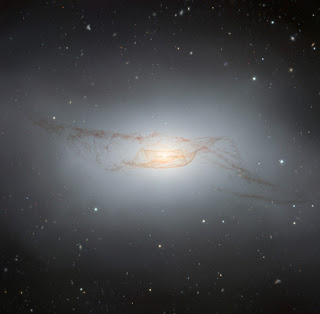In the vast expanse of the universe, nestled within the constellation Virgo, lies a galaxy that captures the imagination of astronomers and space enthusiasts alike. NGC 4753, situated 60 million light-years from our planet, is more than just a member of a quaint cluster on the fringes of the colossal Virgo Supercluster. This celestial body stands out for its intriguing and complex structure, particularly characterized by its peculiar system of dust bands. Crafted to engage and inform, the analysis presented by freeastroscience.com delves into the mysteries of NGC 4753, aiming to enlighten our readers with the latest scientific insights into this fascinating galaxy.
At first glance, through the lens of the Gemini telescope, NGC 4753 presents an array of intricate dust bands enveloping its core. These bands are not merely cosmetic; they tell a story of cosmic proportions. The peculiar feature, which has piqued the interest of the scientific community for decades, was scrutinized by astronomers as early as 1992. Their investigations proposed a compelling narrative: the distinctive shape of NGC 4753 is likely the aftermath of a colossal cosmological event—a merger with a smaller galaxy approximately a billion years ago.
This merger theory offers a plausible explanation for the galaxy's appearance. Viewed perfectly sideways, NGC 4753 reveals its twisted dust bands in full glory. However, should one have the vantage point of facing the galaxy head-on, it would present itself as a slightly deformed spiral galaxy, not unlike many others scattered across the universe. Yet, the question remained: Why do these dust bands appear so contorted?
Recent studies shed light on this enigma, attributing the phenomenon to precession—a deviation in the orientation of the rotation axis of a rotating body. When NGC 4753 assimilated the smaller galaxy, it inherited a trove of dust, settling along its disk. However, the merging entities didn't share the same rotational axis orientation in space, leading to the unique arrangement of dust according to the original galaxy's rotation. This process sculpted the dust into the mesmerizing pattern observed today.
The discovery and ongoing analysis of NGC 4753's dust bands underscore the dynamic and ever-evolving nature of galaxies. It's a vivid reminder of the cosmic dances that shape our universe, leaving behind intricate patterns for us to decipher. As we continue to unveil these celestial mysteries, we're reminded of the universe's complexity and the endless possibilities for discovery that it holds.
At freeastroscience.com, our mission is to unravel the mysteries of the cosmos, presenting them in an accessible and engaging manner. The story of NGC 4753's dust bands is just one example of how, even in the vastness of space, there are tales of mergers, transformations, and the incredible dynamism of the universe waiting to be told. Join us on this journey through the cosmos, where every discovery is a step closer to understanding the grand tapestry of the universe.
Credit: International Gemini Observatory/NOIRLab/NSF/AURA.


Post a Comment